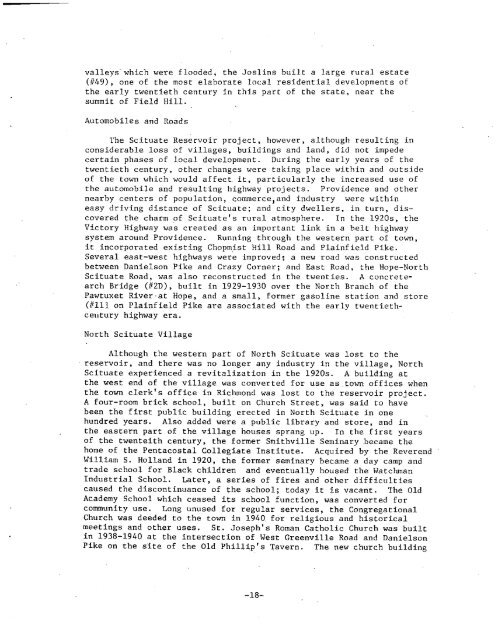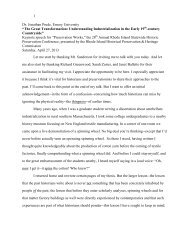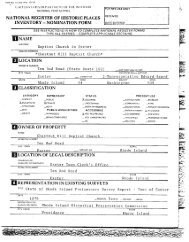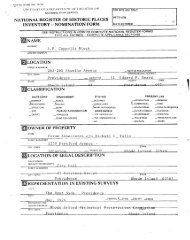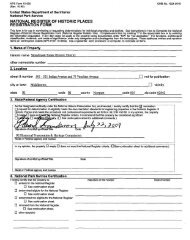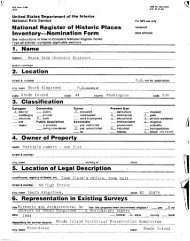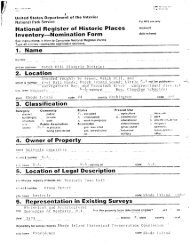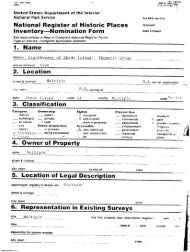Scituate - Rhode Island Historical Preservation & Heritage ...
Scituate - Rhode Island Historical Preservation & Heritage ...
Scituate - Rhode Island Historical Preservation & Heritage ...
Create successful ePaper yourself
Turn your PDF publications into a flip-book with our unique Google optimized e-Paper software.
valleys which were flooded, the Joslins built a large rural estate<br />
#49, one of the most elaborate local residential developments of<br />
the early twentieth century in this part of the state, near the<br />
summit of Field Hill.<br />
Automobiles and Roads -<br />
The <strong>Scituate</strong> Reservoir project, however, although resulting in<br />
considerable loss of villages, buildings and land, did not impede<br />
certain phases of local development. During the early years of the<br />
twentieth century, other changes were taking place within and outside<br />
of the town which would affect, it, particularly the increased use of<br />
the automobile and resulting highway projects. Providence and other<br />
nearby centers of population, commerce,and industry were within<br />
easy driving distance of <strong>Scituate</strong>; and city dwellers, in turn, dis<br />
covered the charm of <strong>Scituate</strong>’s rural atmosphere. In the l920s, the<br />
Victory Highway was created as an important link in a belt highway<br />
system around Providence. Running through the western part of town,<br />
it incorporated existing Chopmist Hill Road and Plainfield Pike.<br />
Several east-west highways were improved; a new road was constructed<br />
between Danielson Pike and Crazy Corner; and East Road, the Hope-North<br />
<strong>Scituate</strong> Road, was also reconstructed in the twenties. A concretearch<br />
Bridge #2D, built in 1929-1930 over the North Branch of the<br />
Pawtuxet River-at Hope, and a small, former gasoline station and store<br />
#111 on Plainfield Pike are associated with the early twentieth<br />
ceittury highway era.<br />
North <strong>Scituate</strong> Village<br />
Although the western part of North Sc-ituate was lost to the<br />
- reservoir, and there was no longer any industry in the village, North<br />
<strong>Scituate</strong> experienced a revitalization in the 1920s. A building at<br />
the west end of the village was converted for use as town offices when<br />
the town clerk’s office in Richmond was lost to the reservoir project.<br />
A four-room brick school, built on Church Street, was said to have<br />
been the first public building erected in North <strong>Scituate</strong> in one<br />
hundred years. Also added were a public library and store, and in<br />
the eastern part of the village houses sprang up. In the first years<br />
of the twenteith century, the former Smithville Seminary became the<br />
home of the Pentacostal Collegiate Institute. Acquired by the Reverend -<br />
William S. Holland in 1920, the former seminary became a day camp and<br />
trade school for Black children and eventually housed the Watchman<br />
Industrial School. Later, a series of fires and other difficulties<br />
caused the discontinuance of the school; today it is vacant. The Old<br />
Academy School which ceased its school function, was converted for<br />
community use. Long unused for regular services, the Congregational<br />
Church was deeded to the town in 1940. for religious and historical<br />
meetings and other uses. St. Joseph’s Roman Catholic Church was built<br />
in 1938-1940 at the intersection of West Greenville Road and Danielson<br />
Pike on the site of the Old Phillip’s Tavern. The new church building<br />
-18-


